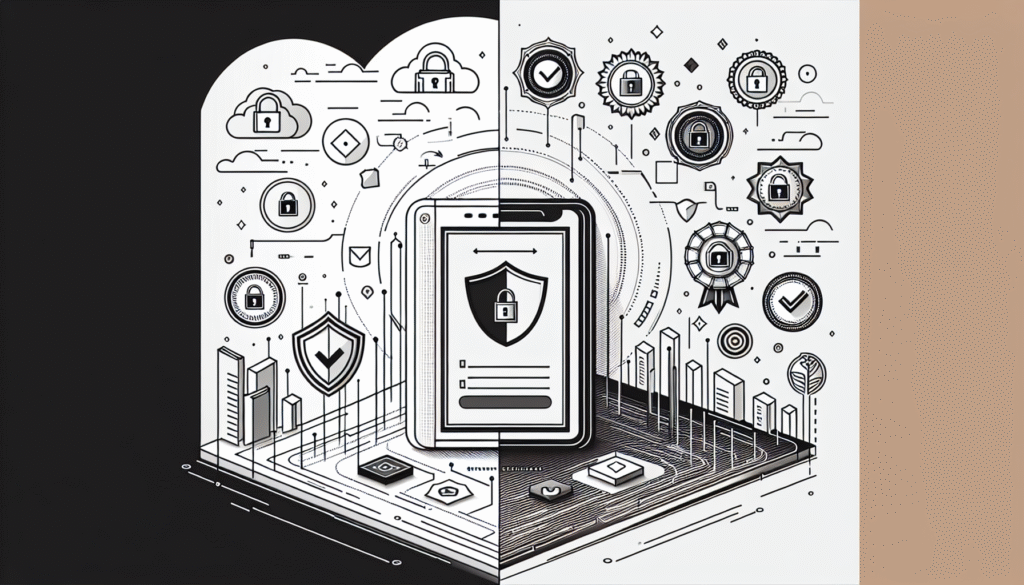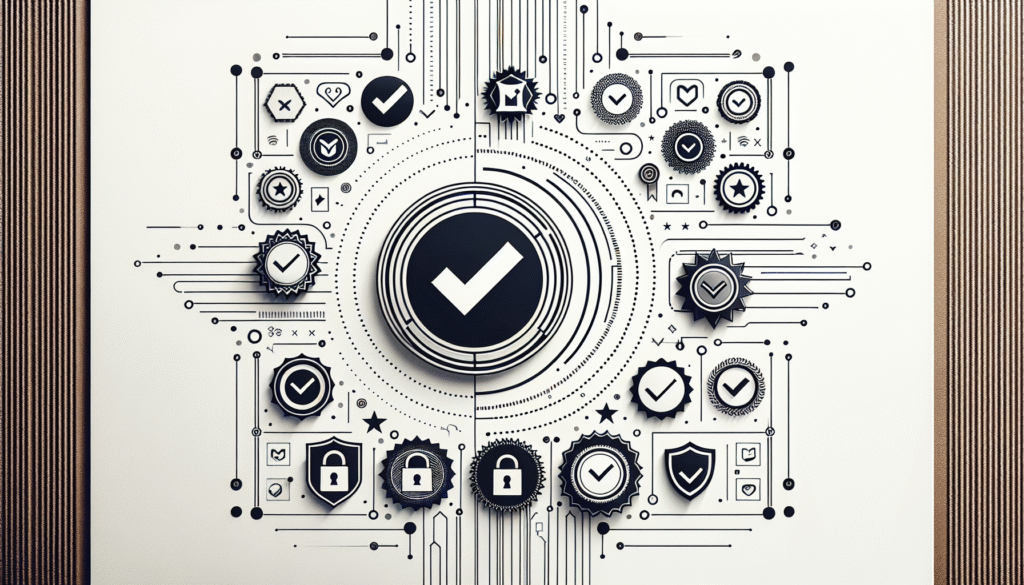Have you ever found yourself puzzling over the secret sauce that makes a website irresistible to visitors, transforming mere clicks into loyal customers? We often wonder about intriguing elements like trust badges and clean layouts and their role in the mystical world of conversion rates. As we dive into this conundrum, let’s explore whether trust badges or sleek, minimalist designs hold more power in converting visitors into buyers.

Understanding Trust Badges and Clean Layouts
Before we get carried away, it’s essential to clearly understand these two crucial components. Trust badges and clean layouts may sound straightforward, but they hold significant sway in the e-commerce world.
What Are Trust Badges?
Trust badges are small icons or symbols that websites display to assure customers of their reliability and security. Picture them as virtual badges of honor, vouches for a website’s credibility. They can indicate secure payment methods, trustful partnerships, or positive reviews from satisfied customers.
These badges come in various forms, like:
- Security badges: Typically display an SSL certificate, indicating a secure connection.
- Payment badges: Show the range of payment methods available, giving customers peace of mind.
- Review badges: Showcase customer reviews, often incorporating star ratings.
- Guarantee badges: Offer a promise of satisfaction, like money-back guarantees.
Defining Clean Layouts
On the other side of the spectrum, we have clean layouts. Picture a minimalist design where simplicity reigns supreme. It’s about uncluttering a webpage to allow easy navigation and focusing on core content. Clean layouts boast lots of white space, straightforward navigation menus, and unobtrusive images and text.
Some key elements of clean layouts include:
- Minimalist design: Prioritizes essentials, removing unnecessary clutter.
- Whitespace utilization: Enhances focus on critical elements and improves readability.
- Simple navigation: Ensures users can find what they’re looking for without hassle.
- Intuitive user experience: Encourages a seamless browsing experience through clear visual hierarchy.
The Impact of Trust Badges on Conversions
We never truly realize how much trust influences our buying decisions until we’re standing at the checkout, hesitating over the “buy now” button. Trust badges can be the nudge that gets potential customers over the line, but how do they actually impact conversions?
Building Customer Confidence
Trust badges are more than just decorative embellishments—they serve a serious purpose. When potential customers see recognizable security signs or respected partner logos, it eases their mind. It’s like receiving a nod of approval from someone we trust, reassuring us that our information and money are safe. This trust leads to increased conversions, as customers feel more secure in their purchasing decisions.
Relationship with Customer Retention
Beyond single transactions, trust badges also cultivate long-term customer relationships. When shoppers have positive experiences and feel assured of a site’s credibility, they’re more likely to return. Over time, these trust symbols can foster brand loyalty, which is invaluable in any industry.
The Invisible Influence
While trust badges seem straightforward, their influence isn’t always directly measurable. They’re like the invisible hands guiding a user through the conversion funnel. Often, it’s not just about the badges customers recognize, but the general sense of security the badges collectively impart. This reassurance leads to higher conversion rates and less cart abandonment.

The Role of Clean Layouts in Conversion Rates
While trust badges play on feelings of safety and assurance, clean layouts work their magic through simplicity and intuitive design.
Enhancing User Experience
A clean layout removes distractions, allowing users to focus on the content that matters most. With a streamlined design, customers can easily navigate through products or services, reducing frustration and improving user experience. This ease of navigation can significantly increase conversion rates as users are less likely to exit the site in frustration.
Prioritizing Visual Hierarchy
A successful clean layout prioritizes visual hierarchy, directing customers’ attention to key elements such as product information, call-to-action buttons, and special offers. By strategically positioning these elements, websites can guide customers through a seamless shopping journey.
Reducing Cognitive Load
It’s no secret that humans appreciate simplicity. A clean layout reduces cognitive load, which essentially means customers make decisions faster and with less effort. This can lead to quicker purchasing decisions and can prevent doubts from creeping in.
Head-to-Head: Trust Badges vs. Clean Layouts
Now that we’ve dissected trust badges and clean layouts individually, let’s compare them head-to-head. It’s essential to remember that while both elements influence conversions, their impacts can be different.
Complementary Elements
In the debate of trust badges versus clean layouts, it’s crucial to recognize that these elements are not mutually exclusive. Together, they can create a powerful synergy. A site with a clean layout can still benefit tremendously from trust badges enhancing its credibility.
| Feature | Trust Badges | Clean Layouts |
|---|---|---|
| Build Trust | High | Moderate |
| Navigation | Low | High |
| Cognitive Load | Moderate | Low |
| Visual Appeal | Low | High |
| Conversion Boost | Moderate to High | Moderate to High |
Scenarios Favoring Clean Layouts
Clean layouts tend to be more effective when a website’s products or services are straightforward and don’t require significant reassurance. If the target audience values ease of use and intuitive navigation, then a clean layout might just tip the scales.
Scenarios Favoring Trust Badges
Conversely, for websites dealing with high-cost items or operating in a niche market where customer apprehension is high, trust badges become indispensable. These badges can reassure buyers and provide an extra layer of comfort that a clear layout alone cannot offer.
Analyzing Real-World Cases
To further our understanding, let’s examine a couple of real-world cases where trust badges and clean layouts driven conversions.
Case Study 1: An Online Retailer
An online clothing retailer decided to test the impact of adding trust badges to their checkout process. Initially focusing on a clean, minimalist design, they added security and payment badges prominently near the checkout button. The result? A significant increase in completed transactions and a notable drop in cart abandonment rates.
Case Study 2: A Tech Gadget E-commerce Site
This site chose to focus on a clean and uncluttered design, minimizing distractions to more effectively showcase their tech gadgets. Emphasizing a straightforward navigation and easy-to-find call-to-action buttons, they experienced higher engagement rates and conversion improvements. Visitors appreciated the simplicity of the buying process with less information overload.
Making the Choice: A Balanced Approach
When deciding between trust badges and clean layouts, the best approach is often to strike a balance. Both elements address different facets of the customer journey and, when used together, can significantly enhance the likelihood of conversion.
Combining Forces
Why choose one when both can be integrated effectively? Imagine a clean layout enhanced with tastefully placed trust badges that don’t interrupt the flow. This combination can cater to both logical navigation and emotional reassurance, crafting an irresistible web experience.
Continuous Testing
It’s worth mentioning the importance of testing. A/B testing variations of design and trust elements can unveil insights into what’s appealing to your audience. By understanding user behavior and preferences, we can optimize our site design for better conversions.
Tailoring to Your Audience
Consider the nuances of your target audience. Are they more concerned with ease and simplicity, or do they require added reassurances? Tailor your approach to fit these tendencies. Run periodic evaluations to stay updated on changing preferences or concerns.
Conclusion: Trust Badges and Clean Layout Synergy
The rivalry between trust badges and clean layouts is one without a strict winner. Rather, it’s an insightful collaboration of factors that can elevate our digital presence and conversion rates. Both trust elements and clean design have their unique strengths, and when combined mindfully, they can transform how potential customers interact with and perceive our website.
Creating a harmonious symphony of trust and simplicity allows us to build a user experience that’s seamless and secure, encouraging visitors to take that leap from browsing to buying. It’s about crafting an environment where trust is palpable, and navigation is intuitive—where conversions aren’t just a possibility, but a certainty.
